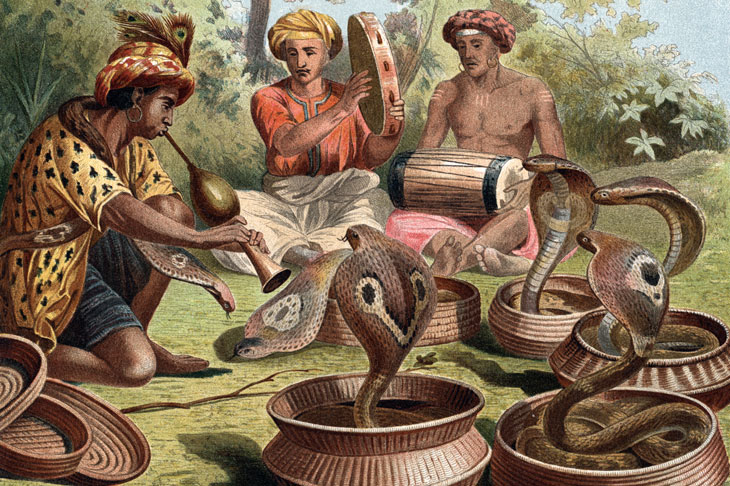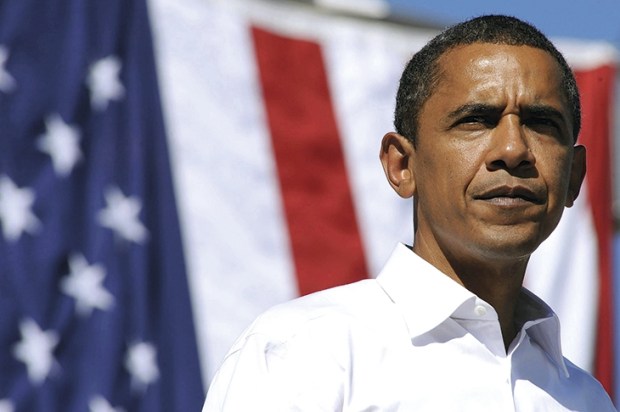The Paul Daniels Magic Show, on a Saturday afternoon in the early 1980s, was a straightforward enough proposition. A wand, a waistcoat and a wig; pick a card, any card….Here was Western conjuring as entertainment, in the music hall and variety tradition. Not much to connect it to gods and spirits; little in the way of holy terror in the sequins of the lovely Debbie McGee.
But, as John Zubrzycki’s new book shows, with Indian magic it has always been considerably more complicated than that. India was mythologised as a land of supernatural marvels for as long as written history goes back. It was there that Herodotus located his giant gold-digging ants. Ctesas of Cnidus, in 400 BCE, described giants, manticores, fountains of gold and two-cubit pygmies with genitals that ‘descend even to their ankles’. The earliest first-hand account, the Indica of Megasthenes, was no less fanciful — mentioning men without mouths who can survive on the smell of food alone, and mystics who live for 1,000 years — but it also described ascetics, mendicant soothsayers and travelling medicine men of a sort who still exist, just about, to the present day.
There’s no clear line in Indian history between the conjuring trick as entertainment and magic as religious ritual; between the austerities of the sadhu or the yogi and the feats of the street performer; between the equivalent of a court masque and a political or devotional ceremony. Here is an astonishingly tangled and promiscuously syncretic history, going back thousands of years and twisting through Hindu, Buddhist and Islamic traditions long before its encounter with the West.
For those who think of Buddhism as a rationalist religion with no hocus-pocus, we are reminded that (in Suzanne Mrozic’s words) Buddha ‘could barely take a step without the earth quaking, gods raining down flowers from the heavens and divine music sounding in the air’. Mohammed put djinns into the Quran. Fourteenth-century Sufi hagiography is full of stories of Sufi saints worsting yogis in miracle contests. And magic was central to pre-modern Indian statecraft, from fortune-telling and longevity spells to spying, police work, warfare and even oratory. The Indrajalavidvyasamgraha, a compilation of magical spells that claimed to ‘ensure victory in a debate’, anticipated the business model of Cambridge Analytica by several hundred years.
The reliability of all this, like that of Cambridge Analytica’s data wizards, could vary. In 1653, for instance, the Mughul Emperor Shah Jahan put his son Dara Shikoh in charge of capturing Kandahar. Shikoh bet the farm on a fraudulent guru who promised he could reduce the fort to ashes if supplied with some wine and a woman. The magician ‘enjoyed the company of the woman for some days’, then legged it: ‘This soon became the talk of the camp.’ Shikoh made a final attempt to raise morale by telling his troops he had had ‘dreams and visions of victory’, and ordered a frontal assault. The Persians held their fire till the attackers were good and close, then let rip:
By the end of the day a thousand men were dead and another thousand wounded. A humiliated Dara retreated to his tent while the Persians played victory music from the ramparts and sent out dancing girls to undulate in full view of the demoralised Mughal soldiers.
(They could have done with one of the exploding iron elephants detailed in another text.)
And, of course, you could perk up your sex life. An ancestor text of the Kama Sutra included spells ‘to make a man’s penis like that of an elephant, ass or horse — another Vedic ideal’; or to
make a woman look more beautiful by removing blemishes and excess body hair… ensure her feet were no longer like an antelope’s, her teeth were not like a bull’s, her movements no longer resembled a cow’s and she stopped snorting — all of which were considered great hindrances to matrimonial happiness.
This history is chronicled in a vast library of texts, real and apocryphal, with titles such as A True Relation without all Exception, of Strange and Admirable Accidents, which Lately Happened in the Kingdome of the Great Magor; or, Magull, Who is the Greatest Monarch of the Indies: or Swallowing the Sword, the Rod Pebbles and Shells and Eating Soap and Glass with the Trick for That; or ‘Regulations for Oiling Camels and Injecting Oil into their Nostrils’; or ‘Omens from the Falling of House Lizards’. These texts are not short: the Ocean of Stories is ‘nearly twice as long as the Odyssey and Iliad combined’, and one edition of the 16th-century Dastan-e-Amir Hamza runs to 42 volumes and more than 52 million words. Zubrzycki shows every sign of having read all these, so you don’t have to.
In his introduction, he describes watching a troupe of a dozen or so jadoowallahs, or street magicians, performing on the outskirts of New Delhi. These days they travel by motorbike, communicate by Whatsapp and post their tricks on Facebook; but their repertoire ‘bore a striking similarity to what the Mughal Emperor Jahangir had witnessed in the early 17th century’.
There’s a core group of tricks that come up again and again: levitation; snake-charming; fire-walking; beds of nails; cup-and-ball tricks; live burial; sword-swallowing (and self-impalement of various sorts); the Mango Tree Trick (where a mango tree grows and bears fruit before the audience’s eyes); the Basket Trick (where an assistant climbs into a basket and is stabbed to pieces with swords before reappearing miraculously unharmed); and various reversible dismemberments and decapitations. Plus the eating and regurgitation of things not usually eaten or regurgitated. An 1851 account quoted one witness:
Tenpenny nails, clasp-knives, gimblets, were all treated as so many items of pastry or confectionary, and I could not but picture to myself the havoc a dozen of these cormorants would commit in an ironmonger’s shop.
The most notorious, of course, is the elusive Indian Rope Trick, where a conjuror throws a rope or chain into the air, mounts to the top and disappears before descending — in the best version of it — in a shower of severed limbs which are, in due course, restored to wholeness. Everyone describes it; nobody reliable seems to have witnessed it first hand. Was it a myth — ‘the most famous trick never performed’? Two chapters, towards the end of the book, put the quest to perform or debunk the Rope Trick at the heart of the 19th-and early 20th-century love–hate tussle between Indian and Western magical traditions.
That tussle is what grounds the second half of the book, as things get a bit less bonkers and we head towards the lovely Debbie McGee. Western magicians started travelling to India to pick up tricks and, in due course, performers. Nineteenth-century exhibition fever saw Indian juggling troupes appear in ‘human zoos’ or tour the provinces. When their unscrupulous backers (one of whom, the former manager of a skating rink, rejoiced in the name of Charles Bastard) went broke, these performers were dumped on the streets, more often than not ending up in the Strangers’ Home for Distressed Asiatics in West India Dock. Here Zubrzycki touches on a social and political strand: nomadic conjurers (like Western Travellers) were periodically associated with thieving and the necromantic arts; and colonial crackdowns on ‘Thuggee’, an imagined caste of professional murderers, would sweep them up. Exploitation verging on slavery was rife.
Yet the odd performer — first and most notably Ramo Samee, and later the fire-walking Kuda Bux — made a sensation. What the late Edward Said identified as ‘orientalism’ was everywhere. Visitors to the ‘India in London’ display in 1885 could eat a menu that included ‘Fish a la Doobash’, ‘Mutton potatonised’, ‘Ducks onionised’ and ‘Fowl Sweetenised’. And just as Western chancers were blacking up and putting on turbans, Indian magicians were adopting top hats and tails.
The most successful 20th-century Indian magician, Sorcar, was an inveterate self-publicist who essentially packaged Western Magic Circle tricks with an orientalised Indian veneer. And not all swamis were swamis. The Chinese conjuror Ching Ling Foo was, gallingly, beaten to the title of ‘Original Chinese Magician’ by Chung Ling Soo (real name: William Robinson). Robinson previously appeared as the Egyptian mystic ‘Achmed Ben Ali’, the Turkish conjuror ‘Abdul Khan’ and the ‘East Indian Necromancer in Oriental Occultism, Nana Sahib’.
Here’s a strange, deeply learned but consistently entertaining salmagundi of marvels, myths and outrageous cons — a surefooted survey of a vast terrain, alive to the cultural and anthropological implications of the subject but majoring on fun anecdotes and bizarre tales. You’ll like it. Not a lot, but you’ll like it.
Got something to add? Join the discussion and comment below.
Get 10 issues for just $10
Subscribe to The Spectator Australia today for the next 10 magazine issues, plus full online access, for just $10.
You might disagree with half of it, but you’ll enjoy reading all of it. Try your first month for free, then just $2 a week for the remainder of your first year.















Comments
Don't miss out
Join the conversation with other Spectator Australia readers. Subscribe to leave a comment.
SUBSCRIBEAlready a subscriber? Log in